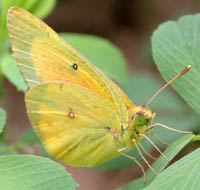
Illustrated by: Sabine Deviche
show/hide words to know
 If the world of fashion were to choose the most fabulously colored animals they would likely decide upon butterflies and birds. These animal fashion statements are well known to most people, but what is less clear is how and why these bright colors have evolved in the animal world. Butterflies and birds are so well dressed that many scientists have made it their life’s work studying these amazing visual displays.
If the world of fashion were to choose the most fabulously colored animals they would likely decide upon butterflies and birds. These animal fashion statements are well known to most people, but what is less clear is how and why these bright colors have evolved in the animal world. Butterflies and birds are so well dressed that many scientists have made it their life’s work studying these amazing visual displays.
Dr. Ron Rutowski, a professor in the School of Life Sciences, has been studying how and why these visual displays have evolved in butterflies since completing his Ph.D. at Cornell in the early seventies. More recently, Dr. Rutowski has begun studies of insect vision and how butterfly behavior has shaped the evolution of insect eyes.
How do butterflies use their vision as they fly around their world? This is a question that Professor Rutowski and his graduate students are studying. One question they are asking and learning more about is how do butterflies find a mate. The orange sulphur butterfly, Colias eurytheme, is the species of butterfly they have chosen to study. Orange sulphur males have bright orange/yellow wings with a black border.
 Male coloration acts as an advertisement to attract females. This type of advertisement is common in the animal world and often referred to as a visual signal. Female orange sulphurs display the same general pattern but are paler and have spots in their wider, black border. All of these brilliant displays are obvious to us, but what you may not know is that males also have a hidden message for females that is invisible to humans. We are unable to see the male’s ultraviolet (UV) reflection, a visual signal that females may use in choosing mates. Animals use visual signals for communication within their species or as signals to other animal species. Other animals, such fireflies use visual signals to identify members of their species and for picking out mates. The Rutowski lab focuses on a number of questions surrounding the difference in color patterns between males and females in the orange sulphur butterfly.
Male coloration acts as an advertisement to attract females. This type of advertisement is common in the animal world and often referred to as a visual signal. Female orange sulphurs display the same general pattern but are paler and have spots in their wider, black border. All of these brilliant displays are obvious to us, but what you may not know is that males also have a hidden message for females that is invisible to humans. We are unable to see the male’s ultraviolet (UV) reflection, a visual signal that females may use in choosing mates. Animals use visual signals for communication within their species or as signals to other animal species. Other animals, such fireflies use visual signals to identify members of their species and for picking out mates. The Rutowski lab focuses on a number of questions surrounding the difference in color patterns between males and females in the orange sulphur butterfly.
One of these mysteries the research team has been looking into is the importance of visual signals when males and females, and males and males interact. Female orange sulphurs likely use the UV coloration to judge which males are the most attractive. The UV signal is an iridescent color. As you look at the iridescent color of butterflies the brightness changes as the wing changes position. So butterflies show off more than one fashion depending on the direction their wings are positioned.
 The Rutowski lab is currently investigating if males flutter around females in ways that show off the brightest part of the UV signals. In the laboratory, Dr. Rutowski measures the brightness and color of visual signals using a special light meter called a reflectance spectrophotometer. In addition, these studies involve many behavioral observations of males and females in their natural habitat, local alfalfa fields in the rural outskirts of Phoenix, AZ. Dr. Rutowski and other members of the lab release butterflies raised in the lab and record the behavioral observations as they watch males chase and show off their colors to female butterflies.
The Rutowski lab is currently investigating if males flutter around females in ways that show off the brightest part of the UV signals. In the laboratory, Dr. Rutowski measures the brightness and color of visual signals using a special light meter called a reflectance spectrophotometer. In addition, these studies involve many behavioral observations of males and females in their natural habitat, local alfalfa fields in the rural outskirts of Phoenix, AZ. Dr. Rutowski and other members of the lab release butterflies raised in the lab and record the behavioral observations as they watch males chase and show off their colors to female butterflies.
Professor Rutowski is also interested in how orange sulphur butterflies produce these visual signals. Looking at a butterfly through a microscope, you see that each wing is covered in tiny scales, similar to scales on a lizard or snake. These scales produce colors in two different ways. Some colors are produced by light reflecting off wing scales, which scientists call structural colors. Other colors are produced by actual chemicals located in the wing scales. These rather large chemicals are called pigments and clump together into granules that absorb all colors except the orange and yellow that you see in orange sulphur wings.
The Rutowski lab is also examining how these visual signals are produced in butterflies. By understanding how the colors are made they can test hypotheses that explain how the difference between wing coloration in males and female butterflies evolved. One hypothesis, or possible explanation, being tested by Dr. Rutowski’s lab is that males have evolved UV signals because they are attractive to females. Females may use UV reflectance as a yardstick to compare males. Males with intense UV signals might be particularly healthy or have good genes. Dr. Rutowski is investigating how well male butterflies are able to produce bright UV reflectance when exposed to hardships in their youth, as larvae and pupae. His research group is also conducting experiments to find out the ways in which colors produced by both reflectance and pigments combine into one final color that butterflies see and use as a signal.
These studies will reveal how much work this fashion show really is for brightly colored males. Do females pay attention to this all-male fashion show? How important are these flashy UV signals to female butterflies? Do males orange sulphurs strike a pose in front of females just at the moment their UV reflectance is most brilliant? Ultimately, Dr. Rutowski and his research team hope to answer these questions and understand just how and why male butterflies have evolved to be so fabulous.
View Citation

Ron Rutowski sees more in butterflies than just beautiful colors and patterns.
Want to learn more about insect vision? Visit our story Did You Know Butterflies Are Legally Blind?
Be Part of
Ask A Biologist
By volunteering, or simply sending us feedback on the site. Scientists, teachers, writers, illustrators, and translators are all important to the program. If you are interested in helping with the website we have a Volunteers page to get the process started.







